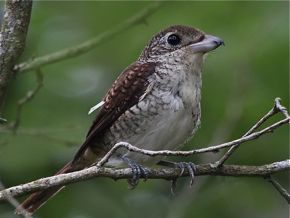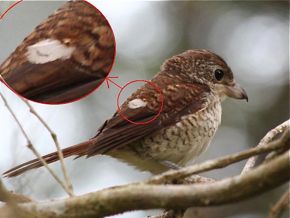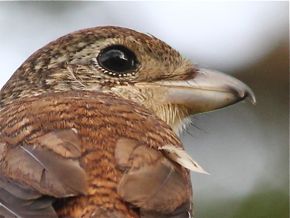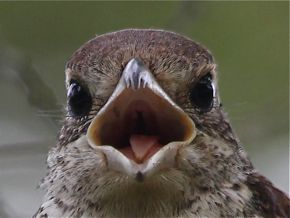“After witnessing a Long-Tailed Shrike (Lanius schach) catching and consuming a caterpillar [LINK] another shrike was encountered. A migratory Tiger Shrike (Lanius tigrinus), a fairly small shrike at about 17 cm to 19 cm, was perched at low level. It was confiding and allowed close range observation.
“While admiring this juvenile Tiger Shrike in preening behaviour, a lone white feather was noticed sticking out like a sore thumb on its right upperpart (above). This feather seemed odd due to its lack of colour, which contrasted sharply with its rich hue of reddish-brown. Furthermore, it was jutting out from the normally smoothed contour of the bird. With a hint of visible dark scaly pattern that seemed to match the dark markings on the shrike’s plumage, this odd feather can be deduced to be from the shrike (and not a foreign object that got stuck there). I suppose that the odd feather will be shed off soon. Can anyone enlighten us whether it is normal for a feather to turn white before being shed?
“Back home, I made another discovery after reviewing the images. At the end of its hooked upper mandible, three pointed tips were visible instead of one (above). On close examination, especially the open beak shot, it resembled an itsy bitsy fork with its two tiny canine-like ‘teeth’ sandwiching the normal sharp tip at the end of its beak. These tiny triangular projections were so near the end of the beak and so small that they were near impossible to spot in the field. The bird’s small physical size and less than ideal lighting condition did not help. The unique ‘teeth’ can only be seen clearly in a few of the close-up images captured under favourable light.
“After a google search, I found out that those extra ‘teeth’ were known as tomial tooth, which was common amongst the falcons. The tomial tooth was also featured in an earlier post (9 Apr 2007 titled Portrait of a Black Baza LINK). For the falcons, the function of the tomial tooth is believed to be used as a tool for breaking the neck of a prey; thereby killing it. Anyone has any idea how they will be used for shrikes?”
Kwong Wai Chong
Singapore
29th February 2012
Note: According to Slim Sreedharan, “Yes, shrikes definitely have a tomial tooth, projecting downward from the upper mandible. It should fit into a similar-sized notch on the lower mandible. Yet, somehow, I think this particular bird shows an abnormally large tomial tooth – I have caught quite a few of these birds, and have never seen one quite as large!”












